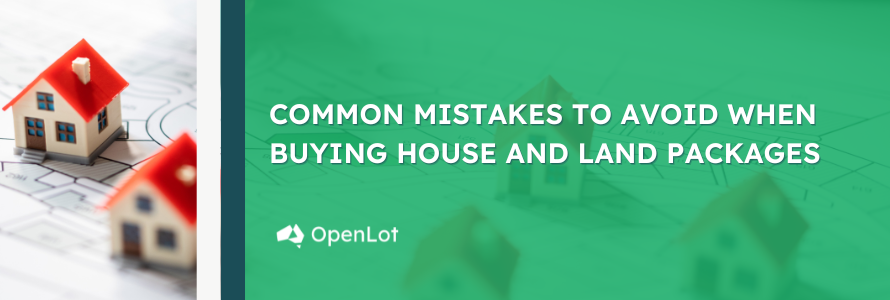
Buying a house and land package is an increasingly popular choice for homebuyers, offering the allure of constructing a brand-new home in a desirable location. While this option provides many benefits, it also comes with challenges that can catch buyers off guard. Understanding these common pitfalls and how to avoid them can save you time, money, and stress throughout the process. Here’s what you need to know.
Pitfalls to Watch Out For
- Not Understanding Inclusions and Exclusions: One of the biggest misconceptions when purchasing a house and land package is assuming that the price includes all the features seen in the display home. The reality is that many display homes feature high-end upgrades that are not included in the base price. These upgrades might include premium appliances, luxury finishes, custom cabinetry, elaborate landscaping, and high-quality flooring. Buyers must carefully review the list of standard inclusions provided by the builder and ask for a detailed breakdown of costs for any desired upgrades. Failing to do so can lead to unexpected expenses and disappointments when your home doesn't match your expectations.
- Underestimating Site Costs: Site costs are another critical factor that many buyers overlook. These costs refer to the expenses related to preparing the land for construction and can vary widely depending on the land's characteristics. Factors like soil quality, slope, drainage requirements, and the presence of rocks or trees can significantly impact the cost. For example, building on sloped land may require additional foundation work or retaining walls, while poor soil conditions might necessitate more extensive site preparation. It's crucial to get a thorough site assessment and a detailed estimate of these costs upfront to avoid budget overruns.
- Ignoring Future Development Plans: When choosing a location for your new home, it's important to think beyond the immediate surroundings. Future development plans for the area can have a significant impact on your property value and lifestyle. For instance, while a quiet, undeveloped area might seem appealing now, it could change dramatically with the introduction of new roads, commercial centers, or residential developments. Conversely, areas slated for new infrastructure projects, such as schools or public transport links, could see property values increase. Researching local council plans and speaking to residents can provide valuable insights into the area's future and help you make a more informed decision.
- Not Considering Builder Reputation: The reputation of your chosen builder is crucial to the success of your home build. Selecting a builder based solely on the lowest price can be a risky move. Builders with a history of delays, cost overruns, or poor workmanship can turn your dream home into a nightmare. To avoid this, research the builder’s track record thoroughly. Look for online reviews, ask for references, and visit homes they have previously built. A reputable builder should be transparent, communicative, and willing to provide detailed contracts and timelines. Choosing a trusted builder with a solid reputation can give you peace of mind and ensure a smoother building process.
Tips for Avoiding Common Errors
- Do Your Homework: Before committing to a house and land package, spend time researching different builders, land developers, and locations. Understand the local property market, including the growth potential of the area. Review all contracts and ask questions about anything that isn’t clear. Knowledge is your best defense against costly mistakes.
- Get Professional Advice: Consider hiring a professional, such as a solicitor or conveyancer, to review contracts and provide advice. They can help you understand the legal implications of your purchase and ensure that all necessary documentation is in order. Additionally, a financial advisor can help you budget effectively, taking into account all potential costs, including site preparation, upgrades, and ongoing maintenance.
- Visit Multiple Display Homes: Visiting several display homes from different builders can give you a better understanding of what’s available within your budget. It also allows you to compare the quality of workmanship and the range of standard inclusions. Take note of the features you like and ask each builder how much these features would cost to include in your home.
- Plan for the Future: Think about your long-term needs and how your home will serve you in the years to come. Consider the layout, size, and location of the home in relation to your lifestyle and family plans. Ensure that the land and home design allow for future expansions or modifications if your needs change.
How to Make Informed Decisions
Making informed decisions when purchasing a house and land package requires careful planning, research, and due diligence. Here are a few final considerations to ensure a successful home buying experience:
- Be Realistic About Your Budget: Understand all the costs involved, including land preparation, legal fees, and any additional features you want in your home. Avoid stretching your budget too thin, as unexpected costs can arise during the building process.
- Build a Strong Relationship with Your Builder: Open communication with your builder is essential. Establish clear expectations from the start and maintain regular contact throughout the construction process. Address any concerns promptly and ensure that all agreements are documented in writing.
- Keep the End Goal in Sight: Remember why you’re buying a house and land package in the first place—whether it’s for investment, lifestyle, or family needs. Keeping your ultimate goal in mind can help you make decisions that align with your long-term vision.
By avoiding common pitfalls and making informed decisions, you can navigate the complexities of buying a house and land package with confidence and achieve the home of your dreams.





